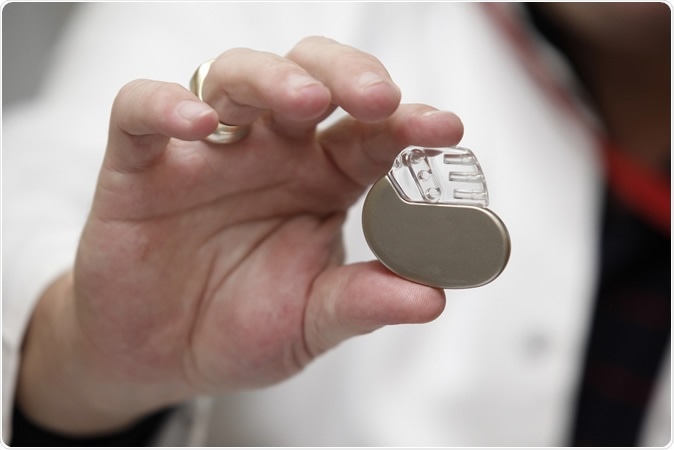Many patients in cardiac arrest have had lifesaving treatment with a defibrillator. However, these machines can also be implanted into patients whose hearts tend to kick off into their own crazy rhythms, making them unable to pump blood.

Implantable defibrillator. Image Credit: Picsfive / Shutterstock
More than 100,000 defibrillators are implanted every year in the EU alone. These machines, nonetheless, do carry their own risks, besides the fact that they are quite expensive. The dangers range from infections to inadvertent leakage of electric current, and lead to complications in at least 25% of implanted devices within 10 years.
Patients who receive defibrillator therapy are those who have developed severe irregularities of the heart’s normal rhythm, called arrhythmias. In such a case, the heart receives a powerful but momentary electrical jolt from a defibrillator which resets the heart’s rhythm to the normal pace. In such patients, implantable defibrillators are inserted into the heart, to prevent such rhythms from becoming established.
The EUropean Comparative Effectiveness Research to Assess the Use of Primary ProphylacTic Implantable Cardioverter Defibrillators (EU-CERT-ICD) study therefore was designed to look at the advantages of defibrillators implanted to prevent arrhythmias in all European countries.
The current study, which comes under the EU-CERT-ICD, is aimed at finding out the right targets for this procedure.
How was the study done?
The researchers looked at almost 1,400 patients who were eligible for a defibrillator. Implants followed in about 970 of them, with medical advice against it prevailing in the other 400+ cases. All patients were at least 18 years old, with cardiomyopathy, and left ventricular ejection fraction of 35% or less.
Every time the heart muscle contracts and then relaxes, it is due to a coupled wave of excitation and regression that spreads across the heart, called depolarization and repolarization, like all muscle fibers. Sometimes, as when heart failure occurs, the sympathetic nervous system that is struggling to keep body responses normal, becomes overactive. This can send confusing signals, disrupting the cardiac muscle repolarization, which could increase the chances of arrhythmias. This is called repolarization instability.
The current study used a novel form of ECG called periodic repolarization dynamics (PRD) to predict patients who are likely to experience these high-risk disturbances of repolarization. It depends on simple measurements which are fed into complex algorithms to identify appropriate subjects.
What does the study show?
Overall, the implanted defibrillator increased survival rates over the next four years by 43%. However, using the PRD, a value of 7.5 or more caused the mortality to be reduced by 75%, while below this value, the decline was only 31%. This significant difference in the likelihood of saving a life would help doctors decide on the utility of this tool far better, say researchers. However, further trials are needed to confirm its safety and value. A trial over a longer period will be needed as well.
One researcher, Georg Schmidt, says, “PRD could become an important decision making tool for physicians. With the additional information, patients who would probably not benefit from a defibrillator could be spared the risk of an implant. Instead we could focus on those whose lives would likely be extended by the device.”
The study was published in the journal The Lancet on September 1, 2019.
Journal reference:
Prediction of mortality benefit based on periodic repolarisation dynamics in patients undergoing prophylactic implantation of a defibrillator: a prospective, controlled, multicentre cohort study. Axel Bauer, Mathias Klemm, Konstantinos D Rizas, Wolfgang Hamm, Lukas von Stülpnagel, Michael Dommasch, Alexander Steger, Prof Andrezej Lubinski, Panagiota Flevari, Markus Harden, Tim Friede, Stefan Kääb, Bela Merkely, Christian Sticherling, Rik Willems, Heikki Huikuri, Marek Malik, Georg Schmidt, Markus Zabel, and the EU-CERT-ICD investigators. The Lancet. September 01, 2019. DOI:https://doi.org/10.1016/S0140-6736(19)31996-8. https://www.thelancet.com/journals/lancet/article/PIIS0140-6736(19)31996-8/fulltext#%20